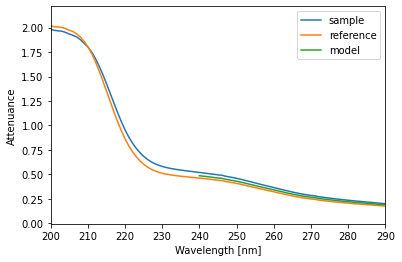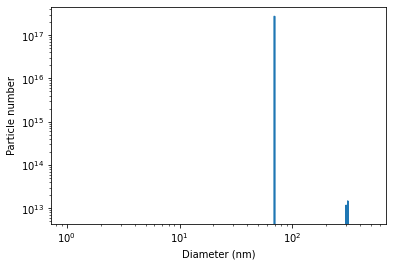Production application: Quality control report template for absorbance, particle size and concentration of Titanium Dioxide based on UV-Vis spectra from SpectroWorks™
This Jupyter-notebook plots spectra from SpectroWorks™ and calculates the absorbance in a given wavelength range. It also calculates the particle size and concentration of samples of Titanium Dioxide.
Test A: Absorbance of TiO2

| Minimum Wavelength (nm) | Maximum Wavelength (nm) | Minimum Absorption |
| 240 | 300 | 10 |
Result: The absorption is calculated and a Pass / Fail result is produced.
| Calculated Absorption | Pass / Fail |
| 11.139 | PASS |
Test B: Particle Size of TiO2

Figure 2: A graph showing the distribution of particle number and particle diameter as calculated using the NanoCuvette S™ and the SpectroWorks™ software.
Description: Calculate the diameter of the particle in nm IF enough particles found within bounds of size, otherwise give NaN.
Parameters: Enter the expected diameter of TiO2 and the tolerance in nanometers.
| Diameter (nm) | Diameter tolerance (nm) |
| 60 | ± 25 |
Result: The diameter of the particles are calculated and a Pass / Fail result is produced.
| Diameter of TiO2 (nm) | Pass / Fail |
| 51.982 | PASS |
Test C: Percentage of particles of TiO2 with given size
Description: Calculate the number of particles within the desired diameter range (set above) as a percentage of total particles and test if above a minimum percentage.
Parameters: Enter the minimum percentage of particle concentration within size bounds relative to the total concentration (%).
| Particles within size bound (%) | 95 |
Result: The number of particles as a percentage of total particles are calculated and a Pass / Fail result is produced.
| Are there at least 95% of total particles within the diameter range 35 < d < 85 nm? | Pass / Fail |
| PASS | |
Test D: Concentration of TiO2
Description: Calculate the total concentration of TiO2 in the sample and test if it is within the bounds of desired concentration.
Parameters: Enter the total volume in cm3 for the sample:
| Sample Volume (cm3) | 1000 |
| TiO2 mass in sample (g) | 20 |
| Density of TiO2 in sample (g/cm3) | 3.78 |
| Dilution factor | 100 |
| Concentration tolerance percentage (%) | 20 |
Result: The total concentration is calculated and a Pass / Fail result is produced.
| Total Concentration of TiO2 in sample (g/l) | Pass / Fail |
| 0.339 | FAIL |